Jumping Worms
Authors: Victoria Wallace and Alyssa Siegel-Miles, UConn Extension
Victoria.Wallace@uconn.edu
Reviewer: Kyle Wickings, Associate Professor, Cornell University
Publication # EXT065 | May 2024
Overview
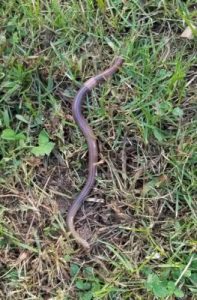
While most earthworms are not native to the United States., many earthworm species provide benefits to urban soils (those in landscapes, lawns and forests) by helping to improve the porousness of the soil, which improves drainage and aeration. Concern has grown over the last decade over several worm species, predominantly of the Amynthas spp., that are reported to cause soil damage, significantly changing its texture and composition. ‘Jumping worms’ is the common name for several similar-looking species.
Distribution and Background:
Originating from Korea and Japan, jumping worms have been observed in the United States since the late 19th century, and are now widespread in the Northeast, Southeast, and Midwest. Worms and cocoons are often distributed by human activity, including movement of potted plants, mulch, bagged leaves, compost, and other landscape materials.
Identification
- Snake-like thrashing or ‘jumping’ movement when disturbed;
- High density of visible, very active adult worms near the soil surface from late June to mid-October;
- Smooth, metallic sheen, often darkly pigmented (glossy dark gray/brown); uniformly colored. 1.5-8” long. Sleek, dry, smooth, and firm body; less slimy to the touch than other earthworms, such as nightcrawlers;
- The cloudy-white to gray clitellum (band) that encircles the body of adult worms is smooth, not raised, and is located nearer to the front of the body;
- May shed ‘tail’/posterior portion if picked up or disturbed. Note: Before the clitellum is visible, juveniles can be identified by their active squirming, snake-like movements, and this ability to drop their tails;
- Castings (feces) are similar in appearance and feel to coffee grounds or cooked ground beef and are found at the soil surface, often in a uniform and deep layer.
Lifecycle and Reproduction:
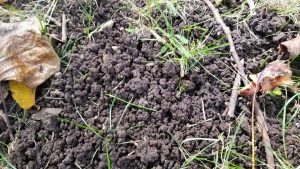
- Annual species with one-two generations per year;
- Parthenogenic (each worm can self-fertilize and reproduce on its own without mating);
- In the fall, adult worms produce small cocoons (2-4 mm wide hardened egg capsules, no larger than the size of peppercorns). Adults are sensitive to cold temperatures and die with the first frost;
- The cocoons overwinter and survive in the soil, then hatch continually the following spring and summer, beginning once soil temperatures rise above 50 F.
European Worm Identification:
European earthworms (nightcrawlers) can live up to eight years and are active in the spring and fall. Their bodies are reddish-pink, thick, slimy, and floppy. The anterior portion is usually darker in color compared to the rest of the body. The raised, pink-red clitellum is more central along the body and only partially encircles the body. When disturbed, the worms slowly wiggle and stretch.
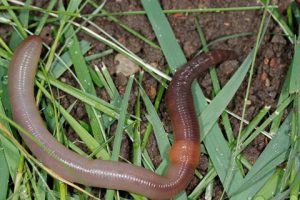
Habitat:
Jumping worms are increasingly observed in urban, managed, and natural landscapes. They live in the topmost layer of the soil, in debris and leaf litter. They thrive in forests, home yards, parks, compost piles, and roadsides.
Ecological Threat:
Jumping worms voraciously consume organic matter from the soil surface, provide little benefit to the soil, and dramatically accelerate the normal process of decay and subsequent nutrient release in the soil. European earthworms distribute their high nutrient-value castings throughout the soil, but jumping worms deposit castings on the soil surface, where the nutrients are unavailable to plants. The jumping worm castings are hardened by the worms’ mucus, and frequently erode away during rain events.mana
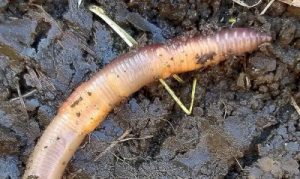
The combination of their castings and aggressive churning of the soil forms a coarse, granular soil structure with large air pockets, which can impact the ability of plants to produce and anchor roots, absorb water, and extract nutrients. When introduced to a property, they can destroy healthy wood-land edges, landscape beds, and turf grass areas, resulting in nutrient leaching, root desiccation, soil erosion, destruction of the soil microbial food web, and plant death.
Management:
Prevention tactics to limit the introduction of jumping worms and cocoons are currently the best methods to manage the spread of these invasive worm populations. They include:
- Using only reputably-sourced soil, as well as heat-treated compost and mulch. High temperatures (>105 F) can kill worms and cocoons;
- Plant bareroot trees or inspect the root ball, soil and mulch of all plants before planting;
- Clean tools, equipment, or shoes after working in landscaped areas.
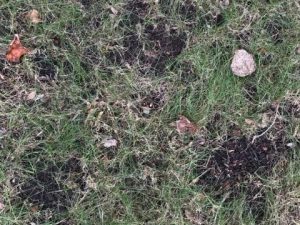
To date, there are no documented effective treatments to control or eradicate existing jumping worm populations. Research is ongoing. Precautions to avoid unintentionally moving jumping worms from one area of a property to another are critical. For small infestations or at smaller sites, hand-collecting worms may, over time, help reduce the number of egg-carrying cocoons at the site. Worms may be drowned in water or sealed in a plastic bag, frozen, and disposed of in trash.
Upload jumping worm observations to iMapInvasives.org to help researchers develop best practices to prevent their spread.
Additional Resources
Bezrutczyk, A., Bowe, A., Brown-Lima, C., Dávalos, A., Dobson, A., Herrick, B., McCay, T. & Wickings, K. (2021). Asian Jumping Worms: A Homeowner's Guide. Cornell University. https://hdl.handle.net/1813/103692
Chang, C.-H., Johnston, M. R., Görres, J. H., Dávalos, A., McHugh, D.,& Szlavecz, K. (2017). Co-invasion of three Asian earthworms, Metaphire hilgendorfi, Amynthas agrestis and Amynthas tokioensis in the USA. Biological Invasions, 20, 843–848. https://doi.org/10.1007/s10530-017-1607-x
Dobson, A. (2020, May 1). Invasives, News, Pests: Jumping Worm Update. Connecticut Gardener. https://www.conngardener.com/jumping-worm-update/
Kostromytska, O. (2021, July 23). Earthworm Invasion! Benefits and Risks. Pro Grow News Summer 2021. https://issuu.com/rick_r/docs/2_pgn_summer.21_digital_edition
Rosen, J. (2020, January 23). Cancel Earthworms. The Atlantic. https://www.theatlantic.com/science/archive/2020/01/jumping-worms-are-taking-over-north-american-forests/605257/
Wisconsin Department of Natural Resources. (n.d.). Jumping Worms: Amynthas spp. https://dnr.wisconsin.gov/topic/Invasives/fact/jumpingWorm
The information in this document is for educational purposes only. The recommendations contained are based on the best available knowledge at the time of publication. Any reference to commercial products, trade or brand names is for information only, and no endorsement or approval is intended. UConn Extension does not guarantee or warrant the standard of any product referenced or imply approval of the product to the exclusion of others which also may be available. The University of Connecticut, UConn Extension, College of Agriculture, Health and Natural Resources is an equal opportunity program provider and employer